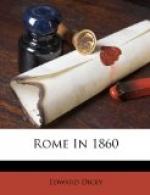Subiaco is some forty odd miles from Rome, and amongst the petty towns of the Papal States is a place of some small importance. The means, however, of communication with the metropolis are of the scantiest. Two or three times a week a sort of Italian eil-wagen, a funereal and tumble-down, flea-ridden coach, with windows boarded up so high that, when seated, you cannot see out of them, and closed hermetically, after Italian fashion, shambles along at jog-trot pace between the two towns, and takes a livelong day, from early morning to late at night, to perform the journey. Other public mode of transit there is none; and therefore, not having patience for the diligence, I had to travel in a private conveyance, and if there had been any one else going from the fair to Rome, which there was not, they must perforce have done the same. As to the details of the journey, and the scenery through which you pass, are they not written in the book of Murray, wherein whoso likes may read them? It is enough for me to note one or two facts which tell their own story. Throughout the forty and odd miles of the road I traversed, I never passed through a single village or town, with the exception of Tivoli; and between that town and Rome, a distance of some twenty miles, never even caught sight of one. After Tivoli, when the road enters the mountains, there are a dozen small towns or so, all perched on the summits of high hills, under which the road winds in passing. Detached houses or cottages there are, as a rule, none—certainly not half a dozen in all—the whole way along. There was little appearance of traffic anywhere. A few rough carts, loaded with charcoal or wood for the Roman markets; strings of mules, almost buried beneath high piles of brushwood, which were swung pannier-wise across their backs; and a score of peasant-farmers mounted on shaggy cart-horses, and jogging towards the fair, constituted the way-bill of the road. The mountain slopes were apparently altogether barren, or at any rate uncultivated. In the plain of the valley, bearing traces of recent inundation from the brook-torrent which ran alongside the road in




